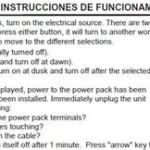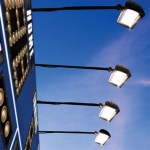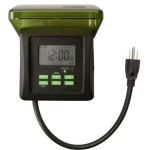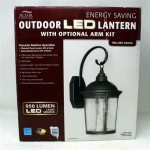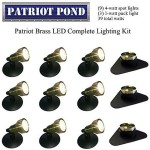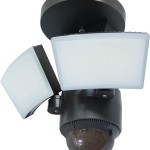Replacing a Motion Detector for Outdoor Light: A Comprehensive Guide
Outdoor lights equipped with motion detectors offer enhanced security and convenience, illuminating pathways and deterring potential intruders. However, these detectors, like all electronic components, are susceptible to failure. A malfunctioning motion detector can lead to lights that remain permanently on, fail to activate when needed, or trigger sporadically for no apparent reason. Replacing the motion detector is often a more cost-effective solution than replacing the entire light fixture. This article provides a detailed guide to replacing a motion detector for outdoor lights, covering essential considerations, necessary tools, and step-by-step instructions for a successful installation.
Before embarking on the replacement process, it's crucial to properly diagnose the problem. Not every issue with an outdoor motion-activated light stems from a faulty detector. Start by checking the bulb. A blown or malfunctioning bulb can mimic the symptoms of a faulty motion detector. Next, examine the wiring connections. Loose or corroded connections can disrupt the flow of electricity and cause erratic behavior. Ensure the power switch controlling the light is functioning correctly. If these basic checks don't resolve the issue, the motion detector is likely the culprit and requires replacement.
Safety is paramount when working with electrical components. Always disconnect the power supply to the light fixture at the circuit breaker before initiating any repairs. This prevents the risk of electric shock. Use a voltage tester to confirm that the power is completely off before touching any wires. Wear appropriate safety gear, including insulated gloves and eye protection. If unsure about any aspect of the process, consult a qualified electrician.
Key Considerations Before Replacement
Several factors should be considered before purchasing a replacement motion detector. Selecting the appropriate replacement ensures compatibility with the existing light fixture and meets the desired functionality.
Compatibility: The first consideration is compatibility with the existing light fixture. Motion detectors come in various configurations, including integrated units and separate modules. Integrated units are typically designed for specific light fixtures and may be difficult to replace independently. Separate modules, on the other hand, offer more flexibility and can often be used as replacements for various fixtures. Verify the voltage requirements of the replacement detector match the existing light fixture to avoid damage or malfunction. Check for compatibility with the type of bulb used in the fixture (e.g., incandescent, LED, CFL). Some motion detectors may not be compatible with all bulb types.
Type of Motion Detection Technology: Motion detectors employ different technologies to sense movement. The most common types are passive infrared (PIR) and microwave. PIR detectors sense changes in infrared radiation emitted by warm objects, such as people and animals. Microwave detectors emit microwave radiation and detect changes in the reflected signal caused by moving objects. PIR detectors are generally more reliable and less prone to false triggers, while microwave detectors offer a wider detection range. Consider the specific application and environmental conditions when choosing a motion detection technology. For instance, in areas with dense vegetation or frequent temperature fluctuations, a PIR detector may be more susceptible to false triggers.
Features and Settings: Motion detectors offer a range of features and settings that can be customized to meet specific needs. These include adjustable sensitivity, detection range, and on-time. Adjustable sensitivity allows you to fine-tune the detector's responsiveness to movement, reducing the likelihood of false triggers. Detection range determines the distance at which the detector can sense movement. On-time refers to the duration the light remains illuminated after motion is detected. Some detectors also offer additional features, such as dusk-to-dawn operation, which automatically activates the light at sunset and deactivates it at sunrise. Choose a replacement detector with features and settings that align with your requirements.
Essential Tools and Materials
Having the right tools and materials is crucial for a smooth and efficient replacement process. The following is a list of essential items:
New Motion Detector: This is the most important item. Ensure it is compatible with the existing light fixture and meets your desired specifications.
Screwdrivers: A set of screwdrivers, including both Phillips head and flathead, is necessary for removing and installing screws.
Wire Strippers/Cutters: These tools are used to strip the insulation from wires and cut them to the appropriate length.
Wire Connectors (Wire Nuts): These are used to safely connect wires together. Choose connectors that are appropriately sized for the gauge of wire used in the light fixture.
Electrical Tape: Electrical tape is used to insulate and protect exposed wires.
Voltage Tester: This tool is used to verify that the power to the light fixture is turned off before starting any work.
Pliers: Pliers can be used to grip and manipulate wires, as well as tighten wire connectors.
Safety Glasses: To protect your eyes from debris and potential hazards.
Insulated Gloves: To provide protection from electric shock.
Ladder (if necessary): If the light fixture is located at a height, a ladder will be needed to access it safely.
Step-by-Step Replacement Process
The following steps provide a detailed guide to replacing a motion detector for an outdoor light:
Step 1: Disconnect the Power: Turn off the power to the light fixture at the circuit breaker. Verify that the power is off using a voltage tester.
Step 2: Access the Wiring: Remove the light fixture cover or access panel to expose the wiring connections. This may involve unscrewing a few screws or releasing clips.
Step 3: Disconnect the Old Motion Detector: Carefully disconnect the wires connected to the old motion detector. Note the color and position of each wire before disconnecting them. This will make it easier to connect the new detector correctly. Typically, there will be three wires: black (hot), white (neutral), and green or bare copper (ground). Use wire strippers/cutters to prepare the wires for reconnection if necessary.
Step 4: Remove the Old Motion Detector: Depending on the type of detector, it may be secured with screws, clips, or a mounting bracket. Remove any fasteners and carefully detach the old detector.
Step 5: Install the New Motion Detector: Position the new motion detector in the same location as the old one. Secure it using the appropriate screws, clips, or mounting bracket. Ensure the detector is properly aligned and securely fastened.
Step 6: Connect the Wiring: Connect the wires from the new motion detector to the corresponding wires in the light fixture. Use wire connectors (wire nuts) to make secure and insulated connections. Match the colors of the wires: black to black, white to white, and green or bare copper to green or bare copper. Twist the wires together tightly and then screw on the wire connector. Ensure the wire connector is securely fastened and that no bare wire is exposed. Wrap the wire connectors with electrical tape for added insulation and protection.
Step 7: Reassemble the Light Fixture: Carefully tuck the wires back into the light fixture housing. Replace the light fixture cover or access panel and secure it with screws or clips.
Step 8: Restore Power and Test: Turn the power back on at the circuit breaker. Test the new motion detector by walking within its detection range. The light should activate when motion is detected and turn off after the pre-set on-time. Adjust the sensitivity, detection range, and on-time settings as needed to achieve the desired performance.
Step 9: Fine-Tune the Settings: Most motion detectors have adjustable settings for sensitivity, range, and duration. Experiment with these settings to optimize performance and minimize false triggers. Consider the surrounding environment and adjust accordingly.
Troubleshooting: If the new motion detector does not function correctly, double-check the wiring connections to ensure they are secure and properly matched. Verify that the bulb is functioning correctly and that the power supply is stable. Consult the manufacturer's instructions for troubleshooting tips specific to the motion detector model.
Replacing a motion detector for an outdoor light is a straightforward task that can be accomplished with basic tools and a little patience. By following these steps and prioritizing safety, you can restore the functionality of your outdoor lighting and enhance the security of your property.

Defiant 270 Degree Black Replacement Outdoor Motion Sensor Df 5716 Bk A The Home Depot

Defiant 270 Degrees White Replacement Motion Sensor For Led Cfl And Incandescent Lights Rs 2701 Wh The Home Depot

Dosaele 2pcs Motion Sensor Outdoor Switch Pir Light Beam Sensing With Relay Output Infrared Activated Replacement Detector For Wall Solar Security Lights Alarm Black Com

Utilitech 240 Degree White Wire In Replacement Motion Sensor And Light The Adapters Department At Com

Defiant 180 Degree Motion Sensor White Outdoor Security Light Df 5416 Wh A The Home Depot

Heath Zenith Motion Sensor Replacement In The Outdoor Wall Light Accessories Department At Com

Motion Sensor Outdoor Replacement Wall Light Switch For Loads

Motion Sensor Replacement Outdoor Pir Detector Led For Loads Light Com

Motion Light Sensor Replacement

Philips Hue Outdoor Motion Sensor Review Macrumors
Related Posts
